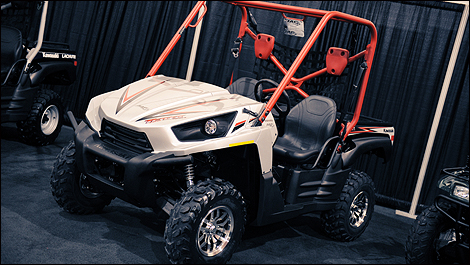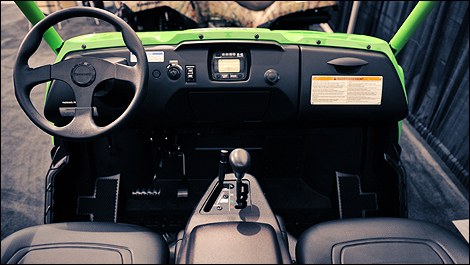The side-by-side utility ATV segment is enjoying unprecedented success across Canada. Since May 27, 2010, ATV clubs have the right to allow these machines on their regulated trail networks. Kawasaki's 2011 Teryx couldn't have arrived at a better time.
The revamped Teryx is now sportier and more generously equipped, offering customers a selection of five models –
750 FI 4x4 (base),
750 FI 4x4 LE,
750 FI 4x4 LE Camo,
750 FI 4x4 Sport and
750 FI 4x4 SSE (Sport Special Edition).
 |
| Photo: Matthieu Lambert/Moto123.com |
A lovely twin-cylinder
All 2011 Teryx models use the same liquid-cooled, 4-stroke, SOHC, 749-cc V-Twin. The larger crankshaft maximizes low-end torque as well as engine longevity. The wide cylinder angle (90 degrees) results in low engine vibration. Plus, no balance shaft is required, making the twin-cylinder lighter and more powerful. Avid riders will still experience a great mechanical feel and raspy engine sound.
The fuel injection system uses 34-mm throttle bodies and a 32-bit CPU. The aforementioned 90-degree configuration and the ultra-low, mid-mounted engine contribute to perfect primary balance while lowering the centre of gravity as much as possible.
Singular solutions
The engine is mated to a dual-range CVT with reverse and shift-on-the-fly 2WD/4WD. Featuring the excellent Engine Brake Control (EBC) system, this transmission offers positive engine braking for easier descents. The torque converter of the dry centrifugal clutch uses a 4-arm timing pulley instead of a 3-arm to ensure a smoother, more precise power delivery and reduce belt wear.
The Variable Front Differential (VFDC), also exclusive to Kawasaki, gives the rider more control over sketchy or slippery terrain through a lever next to the shifter. When left unengaged, the system operates like a normal-slip differential, offering a lightweight and highly-responsive steering. However, as the rider engages the lever to counter wheel slip, the differential can lock completely to provide maximum front-end traction.
 |
| Photo: Matthieu Lambert/Moto123.com |

